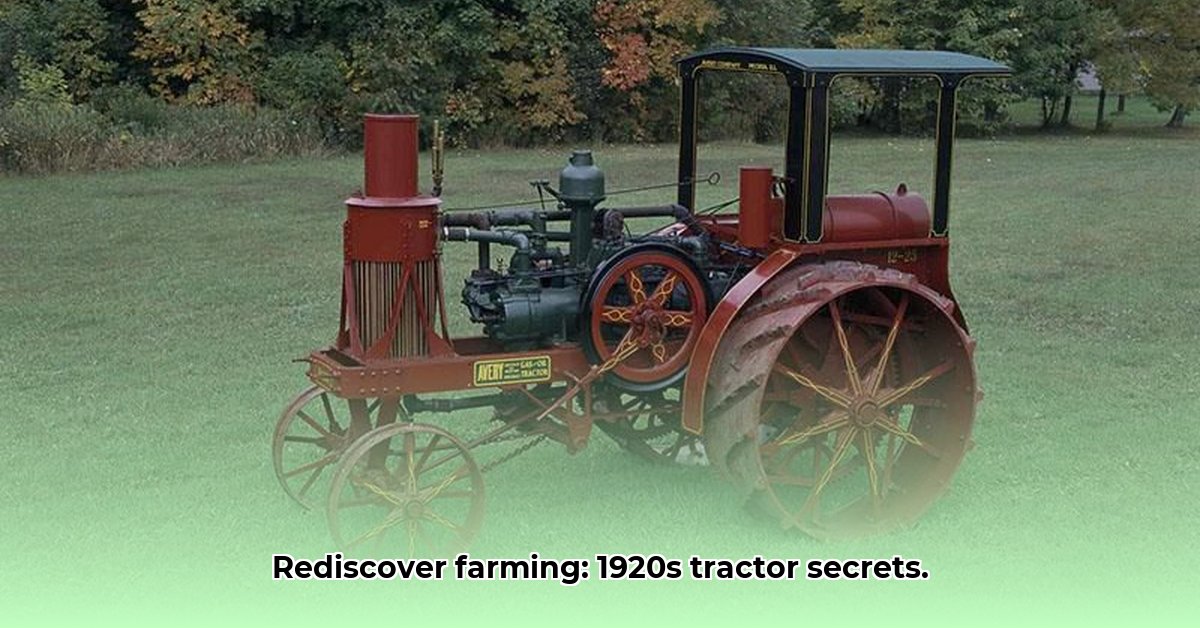
1920 Tractor: A Blast from the Past in Sustainable Farming?
The Fordson Model F, often called the "1920 tractor," though production spanned several years, presents a fascinating case study in agricultural history and sustainable practices. Could this antique machine hold relevance for modern farming, particularly sustainable agriculture? Let's explore its strengths and limitations. For more detailed specifications, see the 1920 tractor specs.
A Compact Design: Advantages and Limitations
This relatively small tractor, built by Ford’s partner Shibaura, offered a significant advantage on smaller farms or in confined spaces. Its compact size potentially minimized soil compaction—crucial for soil health in sustainable agriculture. However, this compact design likely translated to lower power output compared to modern tractors. Was its maneuverability in tight rows worth the reduced power? The answer depends on the specific application.
Fuel Efficiency: A Closer Look
The 1920 tractor's 9.8-gallon fuel tank seems minuscule today. Yet, compared to larger tractors of its time, its fuel consumption was likely lower. Reduced fuel use translates to lower emissions, a key benefit for sustainable practices. However, "fuel-efficient" in the 1920s differs substantially from modern standards. Precise fuel consumption rates are difficult to ascertain without detailed operational data, highlighting the need for careful contextualization.
Versatility: More Than Just Plowing
The Fordson's adaptability stands out. Farmers could attach various implements, enhancing its versatility and reducing the need for multiple specialized machines. This reduced manufacturing and transportation needs, contributing to a lower carbon footprint. However, the sophistication and quality of work from these attachments likely fell short of modern standards. Did its versatility outweigh the limitations in precision and output?
Technological Limitations: A Historical Perspective
The Fordson 1920, while revolutionary for its time, is technologically outdated. Maintaining it requires significant mechanical skills and readily available parts are not guaranteed. It lacks modern technological aids such as GPS, which significantly enhance accuracy and efficiency in modern farming. The lower maintenance costs (assuming self-repair capabilities) must be weighed against the loss of precision and efficiency offered by modern technology. How much lower are these maintenance costs in reality?
The 1920 Tractor's Niche in Modern Sustainable Farming
The Fordson 1920's role in contemporary sustainable agriculture is niche. While its smaller size and potential (relative) fuel efficiency are attractive, its technological limitations and maintenance challenges are significant. Its value lies primarily in its historical significance, offering valuable insights into the evolution of farming technology.
Who Benefits from Studying the Fordson 1920?
Several stakeholders find the 1920 tractor relevant:
| Stakeholder | Key Interests |
|---|---|
| Small-scale, hobby farmers | Potential cost-effectiveness for very specific tasks, requiring mechanical skills. |
| Agricultural historians | Study of farming technology's history and societal impact. |
| Equipment collectors | Value as a rare collectible requiring restoration and maintenance. |
| Sustainable agriculture researchers | Case study for comparing fuel efficiency and overall impact, revealing insights into small-scale, specialized farming. |
Weighing the Risks and Rewards
Operating a 1920 tractor involves risks due to its age:
| Aspect | Potential Problem | Probability | Severity | Mitigation |
|---|---|---|---|---|
| Mechanical Systems | Breakdowns | Moderate | High | Regular maintenance, access to parts (if available) |
| Fuel Efficiency | Relatively Higher Fuel Costs compared to modern machines | Low (compared to other tractors of the era) | Low | Careful operation, potential for alternative fuels |
| Lack of Modern Tech | Lower Precision & Efficiency | High | Moderate | Limited practical options without extensive modification |
| Parts Availability | Repair Delays or Inability to Repair | High | High | Creative solutions, alternative parts fabrication |
Regulatory Compliance: A Critical Consideration
Before using a 1920 tractor, check local and national regulations regarding emission standards and safety requirements. Compliance might present significant challenges for such a vintage machine.
How to Compare Ford 1920 Tractor Fuel Efficiency to Modern Sustainable Farming Equipment
Comparing the Fordson 1920's fuel efficiency to modern sustainable farming equipment requires careful consideration. Direct comparison is difficult due to variations in tractor size, power, technology, and operational conditions. A standardized approach is needed.
Standardizing Fuel Efficiency Comparison
Direct comparison of fuel efficiency is challenging. The Fordson 1920's fuel use depended greatly on factors like the task, soil, and operator skill. Modern tractors vary dramatically in size and technology; a small vineyard tractor differs significantly from a large combine harvester.
To compare effectively:
- Establish a Baseline: Define a specific farming task (e.g., plowing an acre of similar soil).
- Gather Data: Obtain fuel consumption data for both the Fordson 1920 (from historical data and user manuals) and a comparable modern tractor (from manufacturer specifications and user reviews).
- Standardize: Express fuel consumption per acre or hour to control for differing machine capabilities.
- Analyze Outputs: Compare the productivity of both tractors for the chosen task to contextualize fuel usage.
- Include Environmental Factors: Employ a life-cycle assessment encompassing manufacturing, operation, maintenance, and disposal for both machines.
The Case for Vintage Tractors in Specific Sustainable Farming Scenarios
Despite higher maintenance needs, vintage tractors like the Fordson 1920 offer unique sustainability arguments. Their simpler design may lead to easier repairs and maintenance using more readily available parts. This contrasts with modern machines often requiring specialized tools and skilled technicians. In certain situations, their fuel efficiency may even be surprisingly competitive.
Key Takeaways:
- Comparing fuel efficiency requires a standardized approach, accounting for varying operational conditions.
- Modern tractors often exhibit higher efficiency per unit of fuel, but not necessarily per acre worked.
- Vintage tractors offer potential advantages in repair simplicity and potentially reduced embodied energy.
- Consider a comprehensive life-cycle assessment for a more complete picture of sustainability.